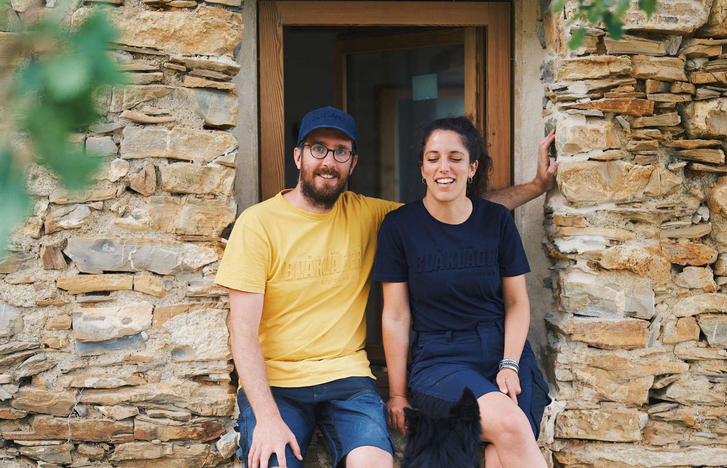 After buying an old, rundown stone house in Italy, architect couple Maddalena Cerruti and Vincent Baisnée set about transforming it into the ultimate sustainable home. Renovating the building from scratch, room by room, they used natural and locally sourced materials to turn the crumbling structure into a property that respects their health, the environment and the building’s history.
After buying an old, rundown stone house in Italy, architect couple Maddalena Cerruti and Vincent Baisnée set about transforming it into the ultimate sustainable home. Renovating the building from scratch, room by room, they used natural and locally sourced materials to turn the crumbling structure into a property that respects their health, the environment and the building’s history.
 So, where did it all begin for the Italian/French couple? “We met in 2018 while volunteering for an architecture NGO in Tanzania,” Maddalena says. “We soon discovered we shared a similar idea about sustainable architecture and designing homes that respect the planet. After this, we worked in Australia and lived in a van for almost two years, to save money. We returned to Europe and decided to begin ateliermavi, our architecture studio. We wanted our inaugural project to be our first home.”
So, where did it all begin for the Italian/French couple? “We met in 2018 while volunteering for an architecture NGO in Tanzania,” Maddalena says. “We soon discovered we shared a similar idea about sustainable architecture and designing homes that respect the planet. After this, we worked in Australia and lived in a van for almost two years, to save money. We returned to Europe and decided to begin ateliermavi, our architecture studio. We wanted our inaugural project to be our first home.”
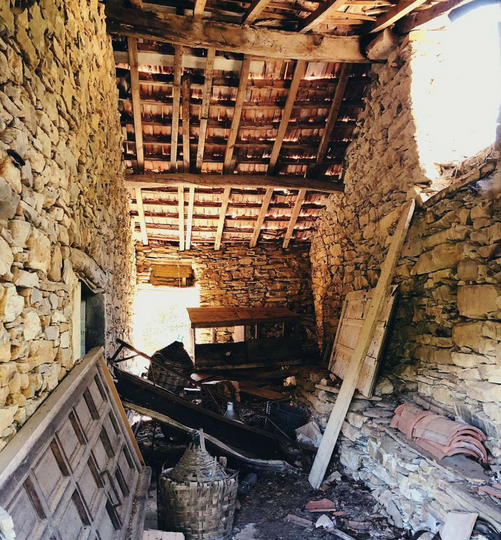 The interior of the structure, which had been vacant for more than 30 years, had crumbling mortar, broken windows, a damaged roof and rooms filled with debris, junk and pests. The entire structure needed to be repaired and restored, but the grounds were also overgrown and needed immediate attention.
The interior of the structure, which had been vacant for more than 30 years, had crumbling mortar, broken windows, a damaged roof and rooms filled with debris, junk and pests. The entire structure needed to be repaired and restored, but the grounds were also overgrown and needed immediate attention.
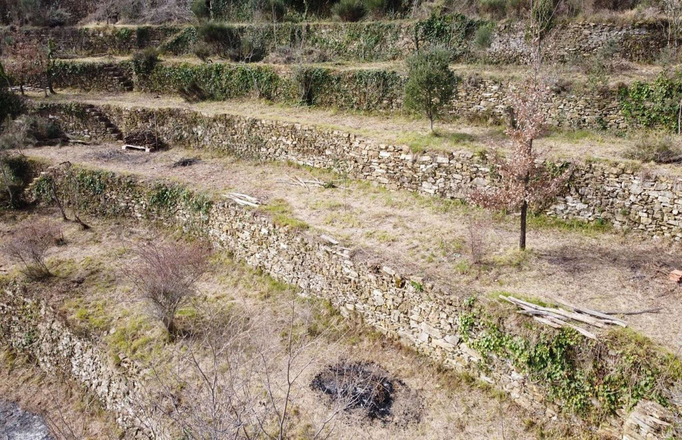 The garden is laid out over seven staggered terraces, so the first job was to clear the site and tackle the overgrown plants that had slowly taken over. The couple worked on the grounds during winter 2020/2021 and, after several weeks, could finally see the boundary of their land. However, clearing the site in its entirety took six months in total.
The garden is laid out over seven staggered terraces, so the first job was to clear the site and tackle the overgrown plants that had slowly taken over. The couple worked on the grounds during winter 2020/2021 and, after several weeks, could finally see the boundary of their land. However, clearing the site in its entirety took six months in total.
 Once the garden was sorted, the couple could get started with clearing the interior. They planned to strip the structure and rebuild it using natural materials and techniques. “We firmly believe that architecture should be made with natural materials and those that can be reused or recycled later, or returned to nature, with a low or negative carbon footprint,” Maddalena says. “These materials, such as timber, lime, earth and straw, allow the house to breathe and create a healthy environment for those living there.”
Once the garden was sorted, the couple could get started with clearing the interior. They planned to strip the structure and rebuild it using natural materials and techniques. “We firmly believe that architecture should be made with natural materials and those that can be reused or recycled later, or returned to nature, with a low or negative carbon footprint,” Maddalena says. “These materials, such as timber, lime, earth and straw, allow the house to breathe and create a healthy environment for those living there.”
 Once the interior was empty, Maddalena and Vincent were free to take on one of the biggest jobs of their renovation: the old roof. It was in a sorry state, so needed to be carefully dismantled and rebuilt. Everything from the old tiles to the rotting timber trusses had to be removed.
Once the interior was empty, Maddalena and Vincent were free to take on one of the biggest jobs of their renovation: the old roof. It was in a sorry state, so needed to be carefully dismantled and rebuilt. Everything from the old tiles to the rotting timber trusses had to be removed.
 The couple also had to remove the internal walls. “Partly made of cement, clay and lime, they were crumbling down, so it was a mandatory step of the renovation,” Maddalena explains. They then spent a lot of time removing the old plaster that was covering the remaining structural walls. “Once this was done, we were able to re-plaster the inside walls with a hemp and lime mix. This provides natural insulation to help keep the home warm.”
The couple also had to remove the internal walls. “Partly made of cement, clay and lime, they were crumbling down, so it was a mandatory step of the renovation,” Maddalena explains. They then spent a lot of time removing the old plaster that was covering the remaining structural walls. “Once this was done, we were able to re-plaster the inside walls with a hemp and lime mix. This provides natural insulation to help keep the home warm.”
In November 2021, the couple hired local builders to demolish the back stone wall of the home. “We love DIY and self-construction but legally, when renovating in Italy, it’s not possible to entirely renovate with your own hands.
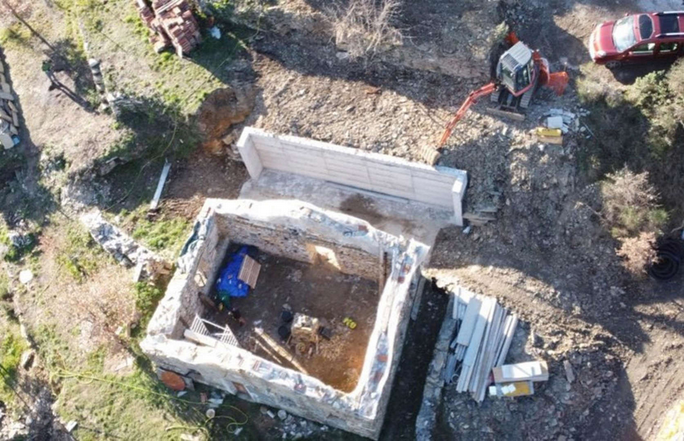 The rear wall was in bad shape, so the couple needed to remove it and then dig out a huge piece of terrain to make space for a new retaining wall. This new wall, seen in this image, holds up the earth bank of the site, allowing new exterior walls to safely be built at the back of the house.
The rear wall was in bad shape, so the couple needed to remove it and then dig out a huge piece of terrain to make space for a new retaining wall. This new wall, seen in this image, holds up the earth bank of the site, allowing new exterior walls to safely be built at the back of the house.
 After months of waiting, the couple’s roofer was finally able to get started on building a new, modern roof. They crafted and installed new timber rafters, on top of which hemp fiber insulation panels were laid.
After months of waiting, the couple’s roofer was finally able to get started on building a new, modern roof. They crafted and installed new timber rafters, on top of which hemp fiber insulation panels were laid.
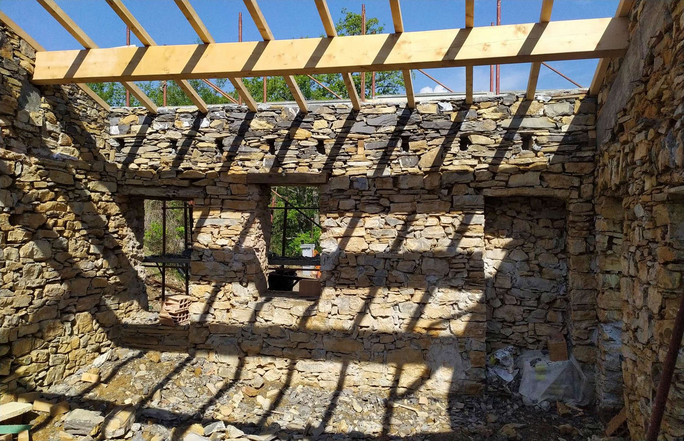 During the process of removing the roof, the couple managed to save two chestnut beams and, instead of throwing them away, opted to put them to use. They used the timber to make almost a dozen lintels for their windows. “We cut the beams to length, sanded them down, treated the wood and finally placed the lintels above the window frames,” Maddalena says.
During the process of removing the roof, the couple managed to save two chestnut beams and, instead of throwing them away, opted to put them to use. They used the timber to make almost a dozen lintels for their windows. “We cut the beams to length, sanded them down, treated the wood and finally placed the lintels above the window frames,” Maddalena says.
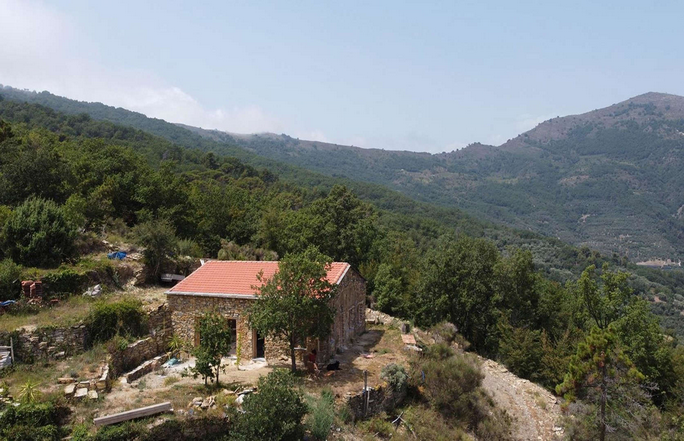 After spending nine months without any cover over their heads, Maddalena and Vince’s new roof was finally finished.
After spending nine months without any cover over their heads, Maddalena and Vince’s new roof was finally finished.
They began rebuilding the external walls they were forced to remove, to create the bathroom and kitchen area. “We used one-foot hemp blocks on a breezeblocks base to isolate the new walls from the ground,” Maddalena says. “And we had experience with neither!”
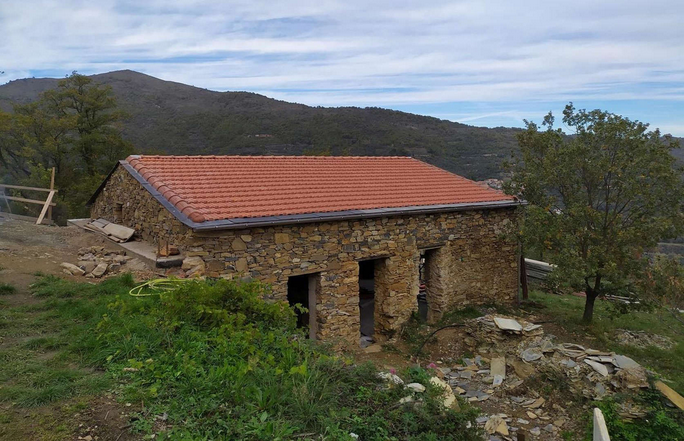 This photograph shows the result, with the new rear walls built up to the concrete retaining wall, finished in local stone and topped with a brand-new roof.
This photograph shows the result, with the new rear walls built up to the concrete retaining wall, finished in local stone and topped with a brand-new roof.
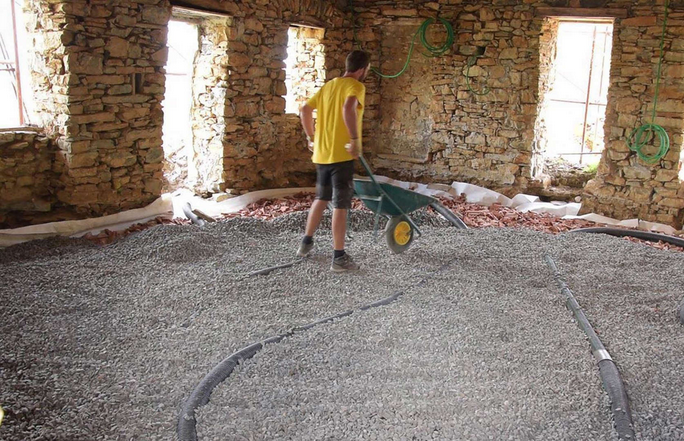 Finally, it was time to start work on the internal floors. The couple’s builder excavated the ground, digging down 1.1 feet (35cm) to ensure the interior floor level matched the ground level outside. “We then added a layer of gravel that will keep the subfloor ventilated,” Vince says. “After this, we poured out hempcrete screed over the top, to complete our insulating subfloor.”
Finally, it was time to start work on the internal floors. The couple’s builder excavated the ground, digging down 1.1 feet (35cm) to ensure the interior floor level matched the ground level outside. “We then added a layer of gravel that will keep the subfloor ventilated,” Vince says. “After this, we poured out hempcrete screed over the top, to complete our insulating subfloor.”
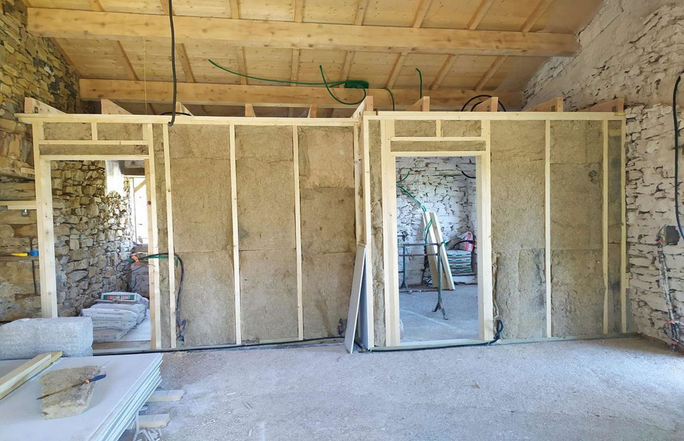 Once the timber stud walls were in place, the pair started installing dry-wall and hemp fiber insulation to ensure interior warmth.
Once the timber stud walls were in place, the pair started installing dry-wall and hemp fiber insulation to ensure interior warmth.
Next, the architects asked their builders to reinforce their windows with reclaimed oak beams, before the glazing was installed.
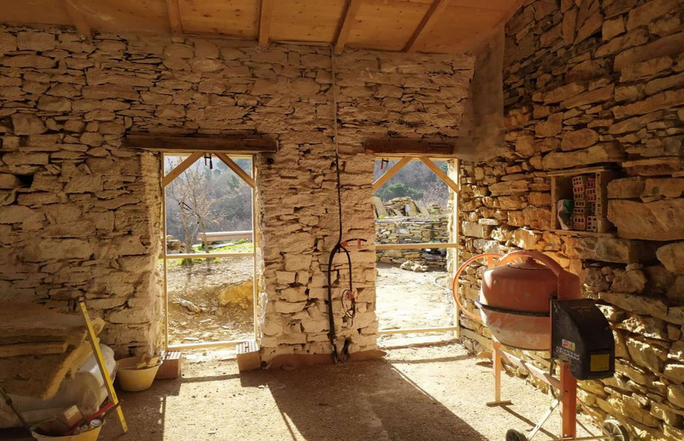 They hired a local carpenter to create custom timber windows. Having airtight, highly efficient windows is an extremely important part of creating a healthy, energy-efficient home.
They hired a local carpenter to create custom timber windows. Having airtight, highly efficient windows is an extremely important part of creating a healthy, energy-efficient home.
One of the biggest jobs was plastering the internal walls, including the new hempblock walls that were constructed at the rear. This image shows the couple plastering the very last wall in their home, in June 2023. “Our walls needed a lot of preparation before they could be plastered,” Vince says. “This included filling, scratching, vacuuming and mudding.”
 This image shows the finish of the main living space, with its gorgeous wood ceiling, lime plaster walls and timber windows. By October 2023, the home had electricity and light. “We had to wait three years for lights,” Maddalena says. “After this, we could paint the walls and install the flooring.”
This image shows the finish of the main living space, with its gorgeous wood ceiling, lime plaster walls and timber windows. By October 2023, the home had electricity and light. “We had to wait three years for lights,” Maddalena says. “After this, we could paint the walls and install the flooring.”
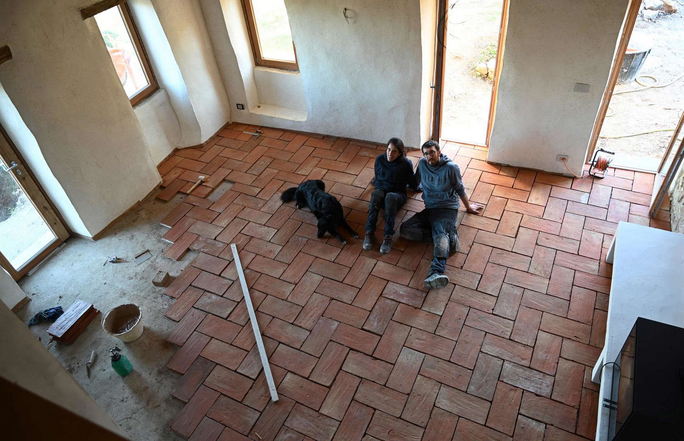 For their internal floors, the couple chose reclaimed terracotta bricks and each one had to be carefully prepared, ready to be laid. “This involved sanding each brick and leaving them to soak in water for at least 24 hours, to prevent them from drawing water from the screed during installation,” Vince says. “Next, we created a screed mixture, applied it to the floor and ensured it was level, sprinkled a little lime on the screed and slightly wet it, then lay the terracotta bricks on top.”
For their internal floors, the couple chose reclaimed terracotta bricks and each one had to be carefully prepared, ready to be laid. “This involved sanding each brick and leaving them to soak in water for at least 24 hours, to prevent them from drawing water from the screed during installation,” Vince says. “Next, we created a screed mixture, applied it to the floor and ensured it was level, sprinkled a little lime on the screed and slightly wet it, then lay the terracotta bricks on top.”
In some rooms, the couple laid the tiles in a simple linear pattern, while in others they went for a lovely herringbone design. “The hardest part was managing the difference in thickness between each tile,” Vince says. “We then grouted and naturally treated them, to seal them.”
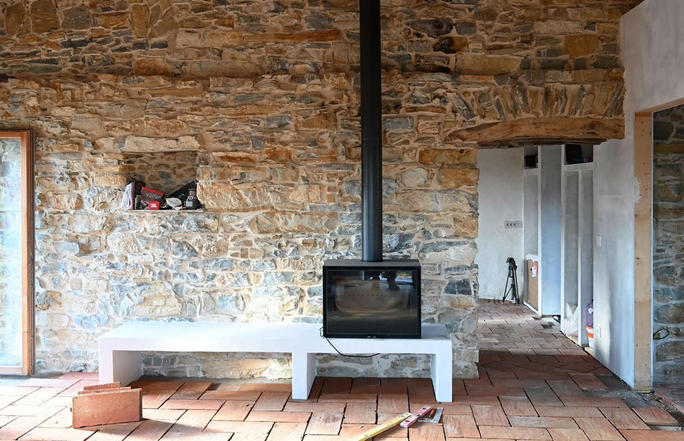 The couple also built their own stand for their brand-new wood-burning stove, which decorates the main living area. “Our home is heated by a very efficient wood stove and to reduce the consumption of our electric water heater, we installed a solar thermal system,” Vince says. “The house being quite compact and well insulated, this is enough to have a very comfortable space in both winter and summer.”
The couple also built their own stand for their brand-new wood-burning stove, which decorates the main living area. “Our home is heated by a very efficient wood stove and to reduce the consumption of our electric water heater, we installed a solar thermal system,” Vince says. “The house being quite compact and well insulated, this is enough to have a very comfortable space in both winter and summer.”
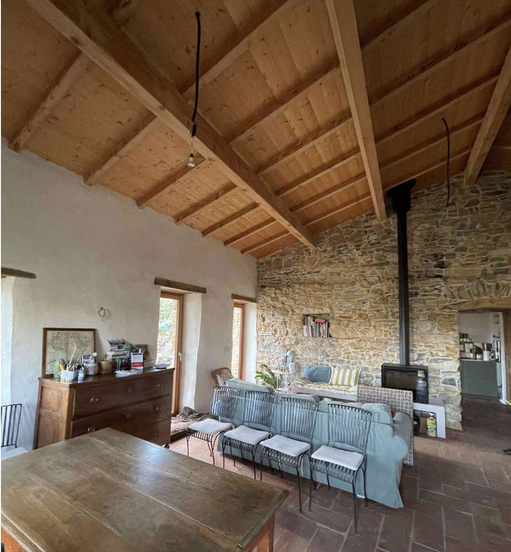 This room is the couple’s finished open-plan living area. At one end, you’ll find their dining space, while at the other there’s a snug lounge. The furniture you can see was mostly sourced from second-hand shops in the local area.
This room is the couple’s finished open-plan living area. At one end, you’ll find their dining space, while at the other there’s a snug lounge. The furniture you can see was mostly sourced from second-hand shops in the local area.
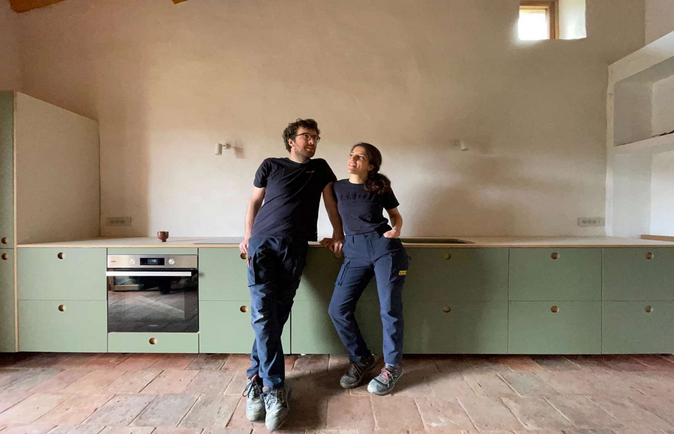 The kitchen is located at the rear of the home, next to the bathroom. For this area, the couple used reclaimed terracotta floor tiles. “The cabinets are made from birch plywood and linoleum, a material that has natural origins. It’s made from cork powder, conifer resin and linseed oil,” Maddalena explains. The couple put together the units themselves, before installing them along one wall.
The kitchen is located at the rear of the home, next to the bathroom. For this area, the couple used reclaimed terracotta floor tiles. “The cabinets are made from birch plywood and linoleum, a material that has natural origins. It’s made from cork powder, conifer resin and linseed oil,” Maddalena explains. The couple put together the units themselves, before installing them along one wall.
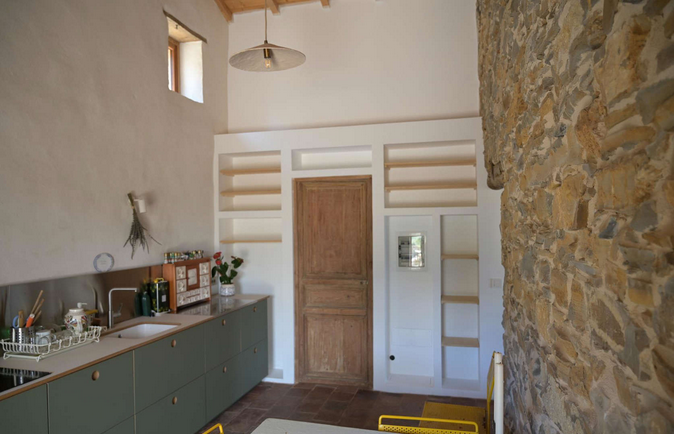 They added a stainless-steel splashback and created a built-in niche pantry for storing everyday essentials.
They added a stainless-steel splashback and created a built-in niche pantry for storing everyday essentials.
 In the bathroom they applied a lime and screed floor and a rough lime render to the walls, followed by a traditional waterproof plaster. “This waterproof lime plaster was one of the hardest things we had to do during the project,” Vince recalls. “It is historically formed from two layers, the substrate (slaked lime and inert materials) and the pastina (equal parts marble powder and slaked lime). The mixture is applied in several layers and then polished. The result is a compact, ecological, durable, smooth and shiny surface.”
In the bathroom they applied a lime and screed floor and a rough lime render to the walls, followed by a traditional waterproof plaster. “This waterproof lime plaster was one of the hardest things we had to do during the project,” Vince recalls. “It is historically formed from two layers, the substrate (slaked lime and inert materials) and the pastina (equal parts marble powder and slaked lime). The mixture is applied in several layers and then polished. The result is a compact, ecological, durable, smooth and shiny surface.”
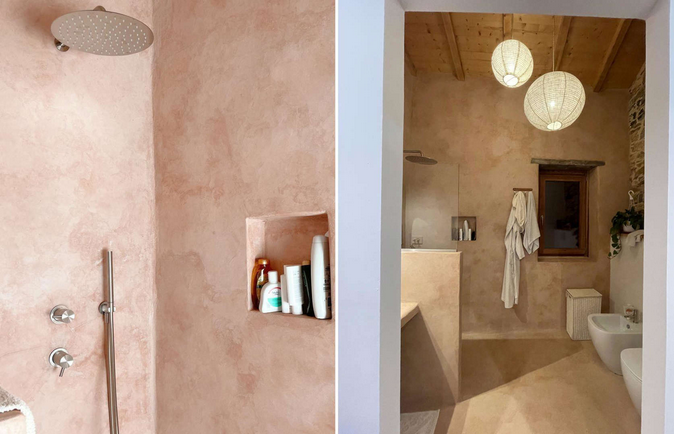 In December 2023 the couple’s wastewater treatment setup was installed. These images show the finished master bathroom. Decorated with the rich, textural tones of the soft pink Pastellone plaster, the space features a handmade walk-in shower, a toilet, a sink and a bidet. Globe-shaped pendant lights hang from the ceiling, adding to the chic finish of the space.
In December 2023 the couple’s wastewater treatment setup was installed. These images show the finished master bathroom. Decorated with the rich, textural tones of the soft pink Pastellone plaster, the space features a handmade walk-in shower, a toilet, a sink and a bidet. Globe-shaped pendant lights hang from the ceiling, adding to the chic finish of the space.
The couple also created a lovely patio, using the old stone slabs that were originally inside the house. They also plan to repoint the outside walls themselves at a later date.
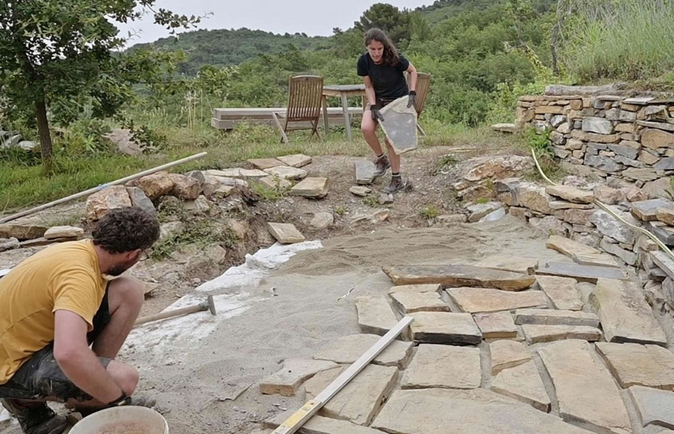 “During the last three years we’ve learned a lot of technical skills, but first and foremost we discovered our endurance,” Maddalena says. “The renovation has allowed us to go beyond our profession and to combine two different aspects of architecture: the theoretical one and the practical one. We are convinced that only by combining these two areas can we arrive at a thorough knowledge of materials and techniques.”
“During the last three years we’ve learned a lot of technical skills, but first and foremost we discovered our endurance,” Maddalena says. “The renovation has allowed us to go beyond our profession and to combine two different aspects of architecture: the theoretical one and the practical one. We are convinced that only by combining these two areas can we arrive at a thorough knowledge of materials and techniques.”
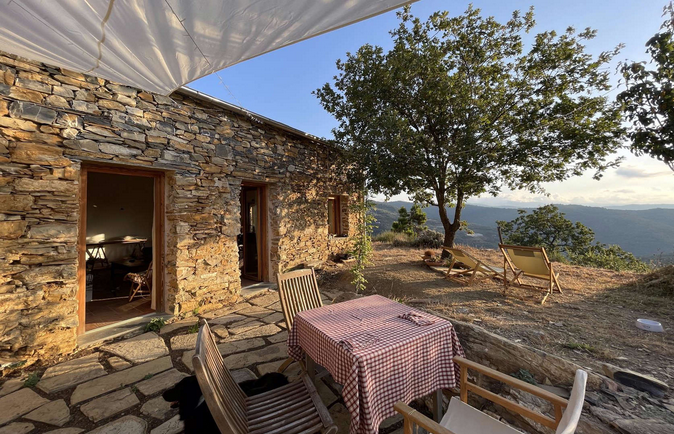 The couple has now moved into the restored Italian property, but they admit there are still plenty of details that need to be finished. “Unfortunately the house is not finished yet,” Vince says.
The couple has now moved into the restored Italian property, but they admit there are still plenty of details that need to be finished. “Unfortunately the house is not finished yet,” Vince says.
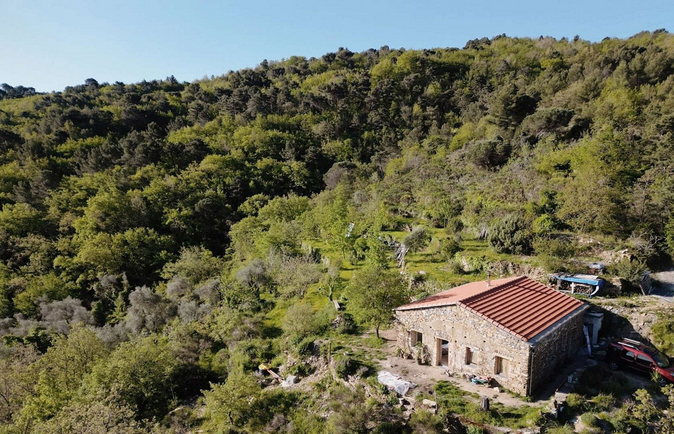 “But the thing that makes us most happy and satisfied is undoubtedly the thermal comfort inside the house. By adding an insulated roof, reducing – where possible – thermal bridges and utilizing thermo-plaster made of lime and hemp, we have taken the house from energy class G to energy class A4 (the highest!).”
“But the thing that makes us most happy and satisfied is undoubtedly the thermal comfort inside the house. By adding an insulated roof, reducing – where possible – thermal bridges and utilizing thermo-plaster made of lime and hemp, we have taken the house from energy class G to energy class A4 (the highest!).”
Check out the couple’s renovation videos on their YouTube channel.
You can read the original article at www.msn.com

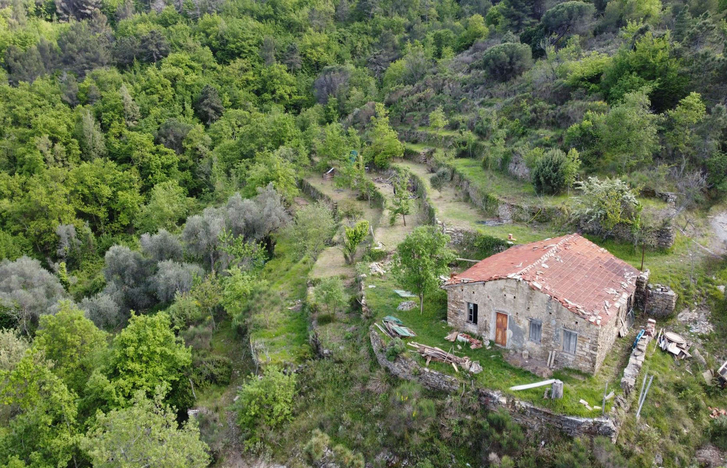 The pair began looking for a fixer-upper that was not too far from their respective families. “We began looking at online listings in France but couldn’t find anything within budget, so we turned our search to Italy. We viewed around 10 homes until we found a rundown house close to the border between our two countries.”
The pair began looking for a fixer-upper that was not too far from their respective families. “We began looking at online listings in France but couldn’t find anything within budget, so we turned our search to Italy. We viewed around 10 homes until we found a rundown house close to the border between our two countries.”  This image shows the new walls complete. The couple then clad them with their salvaged stones, to ensure the exterior looked uniform. “It was a really long and hard process, but we finally got there,” Vince says.
This image shows the new walls complete. The couple then clad them with their salvaged stones, to ensure the exterior looked uniform. “It was a really long and hard process, but we finally got there,” Vince says.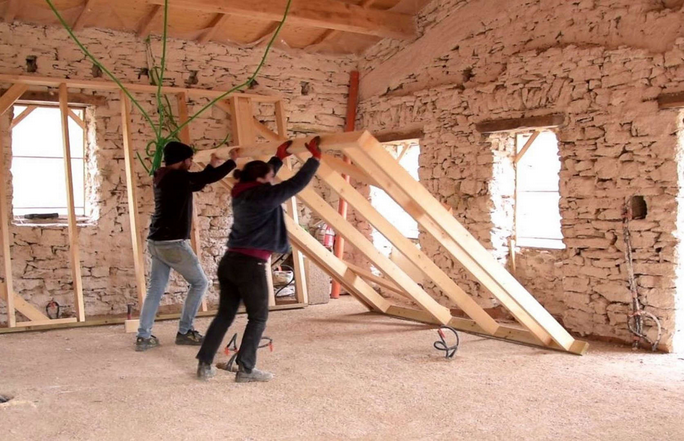 Once the screed floor was set, the duo could install their stud walls, to carve off their internal rooms. “To maximize natural light, we chose to place the living areas to the south of the building,” Maddalena says.
Once the screed floor was set, the duo could install their stud walls, to carve off their internal rooms. “To maximize natural light, we chose to place the living areas to the south of the building,” Maddalena says. 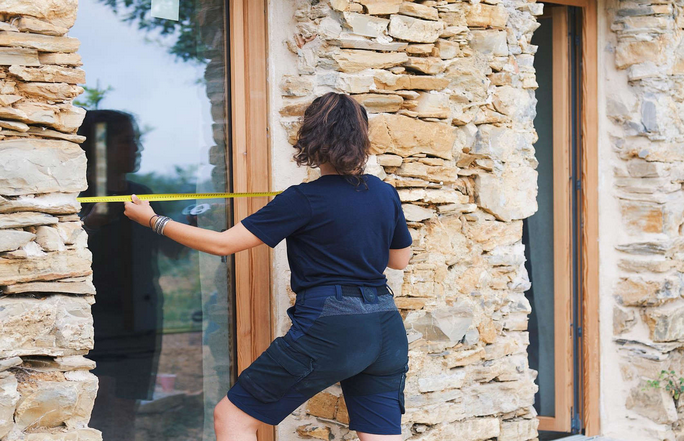 This image shows the lovely timber frame windows in place. Finally, the property was air and watertight.
This image shows the lovely timber frame windows in place. Finally, the property was air and watertight.  This allowed the couple to get started on more important jobs inside the home.
This allowed the couple to get started on more important jobs inside the home. 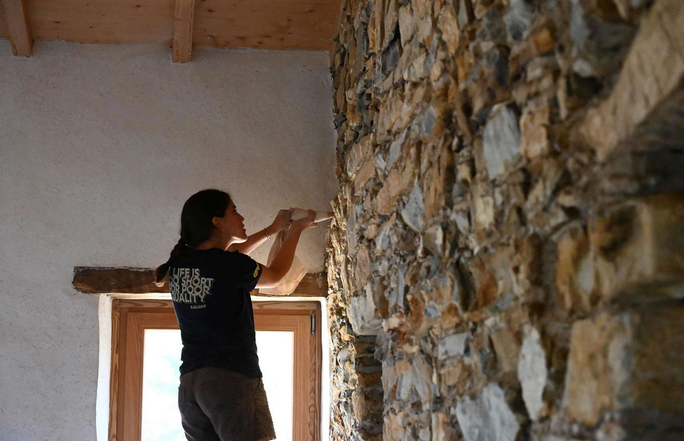 The couple were able to begin repointing the stone once the windows were in.
The couple were able to begin repointing the stone once the windows were in. Here is a close-up of the couple’s dining space. Perfect for easy weekday dinners and hosting, it’s big enough for an intimate dinner party and the table sits next to several windows and a glazed door, which opens onto an exterior patio.
Here is a close-up of the couple’s dining space. Perfect for easy weekday dinners and hosting, it’s big enough for an intimate dinner party and the table sits next to several windows and a glazed door, which opens onto an exterior patio.